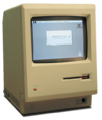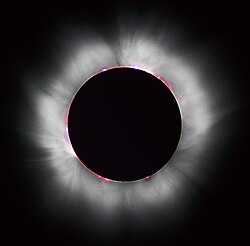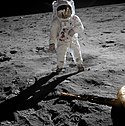2040
| 2040 MMXL |
◄, 20. århundrede ◄ 21. århundrede ► 22. århundrede, ► |
| 2040 |
|---|
| Dødsfald - Fødsler |
| Gregoriansk kalender | 2040 MMXL |
| Ab urbe condita | 2793 |
| Armensk kalender | 1489 ԹՎ ՌՆՁԹ |
| Kinesiske kalender | 4736 – 4737 己未 – 庚申 |
| Etiopisk kalender | 2032 – 2033 |
| Jødisk kalender | 5800 – 5801 |
| Hindukalendere | |
| - Vikram Samvat | 2095 – 2096 |
| - Shaka Samvat | 1962 – 1963 |
| - Kali Yuga | 5141 – 5142 |
| Iransk kalender | 1418 – 1419 |
| Islamisk kalender | 1462 – 1463 |
2040 (MMXL) er det 510. skudår siden Kristi Fødsel. Året begynder på en søndag. Påsken falder dette år den 1. april. Ifølge Nostradamus' forudsigelser kan Jesus dette år og 3000 år frem ventes at vende tilbage til jorden.
Se også 2040 (tal)
Forudsigelser og planlagte hændelser
- 2. maj – delvis solformørkelse.
- August – en besked (Cosmic Call 2) sendt fra den 70-meter store radar i Jevpatorija, Ukraine mod stjernen HD 245409 når dets destination.
- 4. november – delvis solformørkelse.
- 6. november – valg til USAs 64. præsident.
- Kina planlægger en bemandet mission til Månen indenfor tidsrammen 2040 – 2060.
Teknologi
- 6. februar 2040 er den højeste dato der kan repræsenteres i ældre versioner af Apple Macintosh computere.
Billeder
- (c) Luc Viatour, CC BY-SA 3.0
Solformørkelse, denne fra 1999
| Spire Denne artikel om et år, årti, århundrede eller årtusinde er en spire som bør udbygges. Du er velkommen til at hjælpe Wikipedia ved at udvide den. |
Medier brugt på denne side
Forfatter/Opretter: David Vignoni (globe, clock face/ring), Anomie (clock hands), David Göthberg (making the clock red, shadows). Anomie and David G (putting all the parts together)., Licens: LGPL
Globe with clock to represent a "current event"
Calendar icon showing the number 12
Forfatter/Opretter: w:User:Grm wnr, Licens: CC BY-SA 3.0
A Macintosh 128K (that has apparently been upgraded to 512K, see window) running Finder 4.1 American transparent background. Note the add-on "Programmer's Switch" on the lower-left corner of the case, which includes reset and interrupt buttons. Based on w:Image:Macintosh 128k No Text.jpg which was edited by TDS from a version found on the Wikimedia Commons to remove text that obstructed the photograph. (Image:Macintosh 128k.jpg). It is desirable that the current image be recreated in jpg from that source. The original photograph is from the All About Apple Museum, which also shows the back of the machine, confirming it is the original 128K model (Macintosh 128k. All About Apple Museum. Archived from the original on 2004-01-01.). This is an image that has been released into the GFDL. Because of the free license, it is currently the logo of WikiProject Macintosh.
- Short description: Astronaut Buzz Aldrin on the moon
- Full description: Astronaut Buzz Aldrin, lunar module pilot, stands on the surface of the moon near the leg of the lunar module, Eagle, during the Apollo 11 moonwalk. Astronaut Neil Armstrong, mission commander, took this photograph with a 70mm lunar surface camera. While Armstrong and Aldrin descended in the lunar module to explore the Sea of Tranquility, astronaut Michael Collins, command module pilot, remained in lunar orbit with the Command and Service Module, Columbia. The picture features additionally to Aldrin, in his visor as reflections, Armstrong, Earth,[1] the lander, as well as the placed flag and instruments.
- This is the actual photograph as exposed on the moon by Armstrong. He held the camera slightly rotated so that the camera frame did not include the top of Aldrin's portable life support system ("backpack"). A communications antenna mounted on top of the backpack is also cut off in this picture. When the image was released to the public, it was rotated clockwise to restore the astronaut to vertical for a more harmonious composition, and a black area was added above his head to recreate the missing black lunar "sky". The edited version is the one most commonly reproduced and known to the public, but the original version, above, is the authentic exposure. A full explanation with illustrations can be seen at the Apollo Lunar Surface Journal.







